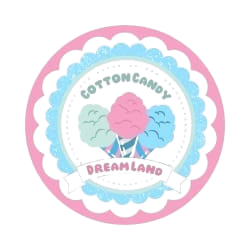Cotton candy is a soft, sugary delight that has captured the hearts of people for over a century. This light, airy treat delights with its vibrant colors and melt-in-your-mouth sweetness, making it a beloved snack at fairs and carnivals worldwide. Its fluffy texture and pastel hues, typically in pink or blue, evoke a sense of nostalgia for many, bringing back memories of childhood fun.
The journey of cotton candy begins with sugar. First, producers heat the sugar and then spin it into fine strands, forming the cloud-like shape that gives cotton candy its signature look.
Cotton candy’s popularity has only grown over time, and its classic charm now extends beyond fairgrounds. Its cultural impact is undeniable, as it continues to symbolize fun, joy, and indulgence for all ages around the world. Let’s take a deeper look at its fascinating origins, how people make it, and the significance it holds in various cultures.Cotton candy, that sugary, cloud-like treat, is often associated with fairs and carnivals, evoking memories of childhood fun and joy. Here’s a detailed look at this iconic snack:
Key Takeaways:
Fun Facts: A single strand of cotton candy is thinner than a human hair! And the longest cotton candy ever made measured a mind-blowing 1,400 meters.
Origin and Name: Originally known as “fairy floss,” it made its debut at the 1904 World’s Fair in St. Louis. Later, in the 1920s, dentist Josef Lascaux renamed it “cotton candy” to appeal to a broader audience.
How It’s Made: Cotton candy is made by heating sugar and spinning it into fine, delicate strands through tiny holes, which cool rapidly in the air to form its fluffy texture.
Modern-Day Production: Today’s cotton candy machines offer advanced features like digital temperature control, multiple flavor options, and larger spinning bowls to create even more cotton candy faster.
Flavors and Variations: While the classic pink and blue flavors are still favorites, cotton candy comes in many other flavors such as gingerbread, bubble gum, mint, and even dill pickle.
Global Names: Known as “candy floss” in England, “dragon’s beard” in China, and “old ladies’ hair” in Greece, this treat has different names and variations across the world.
Pop Culture Impact: From films like Charlie and the Chocolate Factory to TV shows like The Simpsons, cotton candy has remained a symbol of fun and childhood nostalgia.
It,s originally known as “fairy floss,” made its debut at the 1904 World’s Fair in St. Louis, where it quickly became a popular attraction. Vendors create the treat by heating sugar and spinning it through tiny holes, transforming it into fine, delicate strands that resemble fluffy cotton. This method of spinning sugar marked a revolutionary innovation at the time.
In the 1920s, dentist Josef Lascaux coined the term “cotton candy” to avoid confusion with the original name, “fairy floss,” which had become associated with a more whimsical, old-fashioned image. The new name helped the treat gain wider appeal and solidify its place in modern candy culture.
Over the years, cotton candy has evolved to include a variety of flavors and colors.
Today, people enjoy cotton candy worldwide, with different cultures giving it unique names and variations. Its simple yet magical appeal remains timeless, making it a beloved treat across the globe.
The Origins of Cotton Candy

Early Forms of Spun Sugar
The history of cotton candy traces back centuries, originating in Renaissance Italy. During this period, skilled chefs melted sugar and spun it by hand, crafting delicate strands of spun sugar. This labor-intensive method involved using forks to pull the candy into thin threads, which they elegantly draped over broom handles. However, these early forms of spun sugar were not only time-consuming to produce but also quite expensive, making them a luxury item.
Invention by Morrison and Wharton
The turning point for cotton candy occurred in 1897 when dentist William Morrison partnered with confectioner John C. Wharton to invent a revolutionary machine that changed the candy landscape forever. They designed a device that heated sugar in a spinning bowl equipped with tiny holes, allowing the melted sugar to transform into light, fluffy strands. Initially, they dubbed their creation “fairy floss.”
Introduction at the 1904 World’s Fair
It made its grand debut at the 1904 St. Louis World’s Fair, marking a pivotal moment in its history. Morrison and Wharton sold an impressive 68,000 boxes of their sugary delight over six months, with each box priced at 25 cents. This landmark event launched cotton candy into the spotlight, establishing it as a cherished snack at fairs and festivals worldwide. Today, it evokes sweet nostalgia for many.
How Cotton Candy is Made
Ingredients and Equipment
Creating cotton candy is a straightforward process that requires only two main ingredients: sugar and air. The essential equipment includes:
- A cotton candy machine
- Flavored sugar (such as pink vanilla or bubble gum)
- A collection cone or bag
The Spinning Process
The process of making cotton candy is simple and fun. Here’s how it works:
- Add Flavored Sugar: Begin by placing flavored sugar in the center of the cotton candy machine.
- Heat the Sugar: The machine heats to approximately 300 degrees Fahrenheit, melting the sugar.
- Spin the Sugar: As the center spins, the melted sugar forces through tiny holes, forming fine strands.
- Cool and Fluff: These strands cool rapidly in the air, resulting in the fluffy texture that we all adore.
Modern Production Techniques
Today, It`s machines have advanced significantly, featuring innovative designs and enhanced technology that improve both functionality and efficiency. Notable modern enhancements include:
- Digital Temperature Control: This feature ensures precise heating for optimal results.
- Flavor Variety: Machines can hold multiple flavors and colors of sugar, allowing for a creative assortment.
- Larger Spinning Bowls: These enable the simultaneous production of greater quantities of cotton candy, enhancing efficiency and allowing vendors to serve customers quickly.
Ultimately,It is not just a sweet treat; it provides an enjoyable experience that brings joy to many at fairs and festivals! at fairs and festivals!
The Evolution of Cotton Candy Flavors

Traditional Flavors
Yet, as time progressed, it gained widespread popularity in two primary colors: pink and blue. These vibrant hues have become synonymous with the classic flavors of cotton candy, continuing to be favorites among enthusiasts today.These distinctive colors have come to symbolize the classic flavors of cotton candy, which remain beloved by many today.
Innovative and Unique Flavors
Now, you can find a wide variety of flavors, including:
- Dill pickle (green)
- Gingerbread (purple)
- Bubble gum (pink)
- Mint (green)
- Piña colada (yellow)
This evolution shows how cotton candy has adapted to meet different preferences.
Cultural Variations in Flavor
Similarly, in Japan, vendors delight customers with unique flavors like matcha or sake. Additionally, in Mexico, you can savor flavors such as tamarind, adding a local twist to this classic treat.It is famous for its airy, melt-in-your-mouth sweetness, has a fascinating history that traces back to the late 19th century. With such a wide range of flavors available today, It continues to be a fun and exciting treat for everyone!
Cotton Candy Around the World
What exactly is cotton candy? Essentially, it is a fluffy, sugary treat made from spun sugar, often found at fairs and carnivals.
Globally,It enjoys popularity under various names. For example, in England, people refer to it as “candy floss,” while in China, it goes by “dragon’s beard. Meanwhile, in Greece, it has a whimsical name: “old ladies’ hair.”
Global Popularity
It has evolved beyond being merely a fairground snack; it has become a cherished treat enjoyed in various settings worldwide. For instance, at fairs and carnivals,It serves as a quintessential attraction, drawing crowds with its fluffy, whimsical appearance. You will also see it at special occasions, as often graces birthday parties and celebrations, bringing joy to both children and adults.
International Variations
Different cultures have their own unique takes on cotton candy.
In summary, cotton candy has transformed from a simple delight into a global phenomenon, showcasing creativity in both flavors and presentation. This fluffy, colorful treat made from spun sugar melts in your mouth, delivering an instant burst of sweetness. Its popularity at fairs ensures that it remains a fun and beloved snack for all ages. With a variety of names and flavors,It continues to enchant people around the world!
Fun Facts About Cotton Candy
Nutritional Information
A typical serving of cotton candy contains around 110 calories, making it a relatively light treat. Surprisingly, it has less sugar and fewer calories than a can of soda. Furthermore, It is fat-free and gluten-free, which makes it a lighter option compared to many other desserts.
Record-Breaking Feats
Did you know that the longest cotton candy ever made measured an astonishing 1,400 meters, roughly the length of 13 football fields?
Interesting Uses and Mash-Ups
In some regions, street vendors use cotton candy as a canvas for artistic creations, showcasing their creativity. Moreover, It has inspired a variety of whimsical recipes, adding a playful touch to desserts.
Did you know? A single strand of cotton candy is thinner than a human hair!
The Impact of Cotton Candy on Pop Culture
Cotton Candy in Movies and TV
It has left its mark in numerous films and television shows, often representing childhood joy and nostalgia. For example, it frequently appears at fairs and carnivals, showcasing scenes that evoke fun and excitement. Notable examples include “Charlie and the Chocolate Factory,” where the enchanting world of Willy Wonka features cotton candy as a delightful treat. In “The Sandlot,” a classic scene showcases kids enjoying cotton candy at a fair, capturing the essence of summer fun. Additionally, “The Simpsons” often includes cotton candy in carnival scenes, highlighting its cultural significance.
Cotton Candy at Festivals and Fairs
Moreover, It is a staple at many events, contributing to its widespread popularity. It often serves as a must-have treat at state fairs, attracting crowds with its fluffy appeal. Additionally, at concerts and events, vendors typically sell cotton candy, adding to the excitement of the occasion.
Cotton Candy-Inspired Products
The influence of cotton candy extends beyond just food. Innovative products inspired by this treat have emerged, including cotton candy-flavored snacks, ranging from popcorn to ice cream. Furthermore, you can find cotton candy-scented candles that bring the sweet aroma into homes. Some fashion items even feature clothing and accessories adorned designs, appealing to fans of this nostalgic snack.
In conclusion, It is more than just a sugary delight; it symbolizes joy and childhood memories for many. Its presence in pop culture continues to grow, making it a beloved icon of fun and celebration.
What is Cotton Candy?
In essence, It is a fluffy, sweet treat made from spun sugar. It enjoys popularity at fairs and carnivals, where it melts in your mouth and delivers a burst of sugary flavor in vibrant pastel colors. Its lasting appeal at various events and gatherings ensures that cotton candy remains a cherished treat for generations to come.emains a cherished treat for generations to come.e in our hearts and minds, ensuring it remains a cherished treat for generations to come.
Conclusion
Regardless of how you enjoy it, one thing is certain: cotton candy is a beloved treat that has stood the test of time. From its modest origins more than a century ago, it has evolved from a simple fairground snack into a global favorite. Today, cotton candy can be found at festivals and fairs all over the world, from Japan to Spain, delighting people of all ages.
Frequently Asked Questions
What is cotton candy made of?
It is created from sugar that is heated and spun to form airy strands.
Who invented cotton candy?
It was invented in 1897 by dentist William Morrison and confectioner John C. Wharton.
Why is it called cotton candy?
The term ‘cotton candy’ was coined in 1921 by dentist Josef Lascaux, as it resembles fluffy cotton.
Where did cotton candy first appear?
It was first introduced to the public at the 1904 World’s Fair in St. Louis, Missouri.
What flavors does cotton candy come in?
It is available in a delightful variety of flavors.
What is cotton candy made of?
Cotton candy is made from sugar that is heated and spun into fine strands.
Who invented cotton candy?
Cotton candy was invented in 1897 by dentist William Morrison and confectioner John C. Wharton.
Why is it called cotton candy?
It was renamed “cotton candy” in 1921 by dentist Josef Lascaux due to its fluffy, cotton-like appearance.
Where did cotton candy first appear?
It was introduced at the 1904 World’s Fair in St. Louis, Missouri.
What flavors does cotton candy come in?
Cotton candy now comes in a variety of flavors, including traditional pink vanilla, bubblegum, and innovative ones like gingerbread and piña colada.
4o mini







